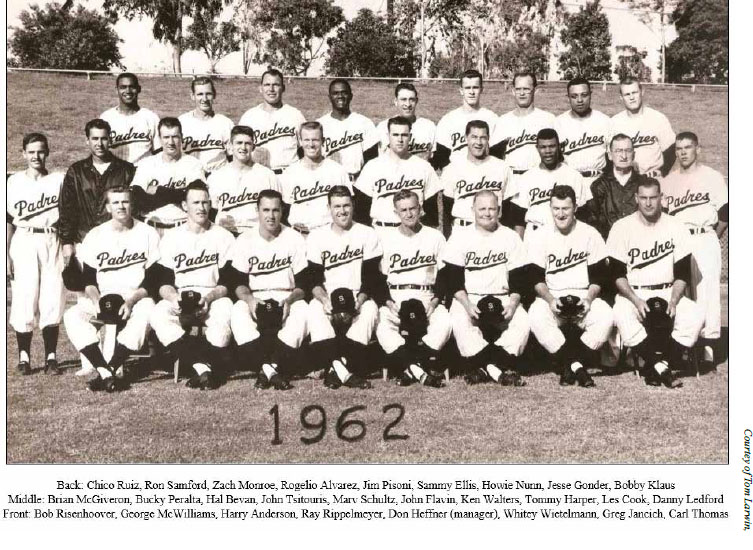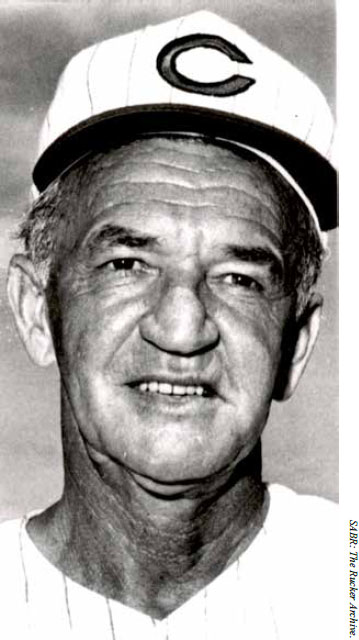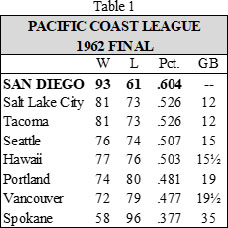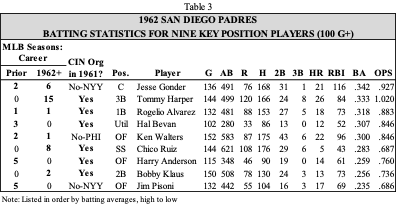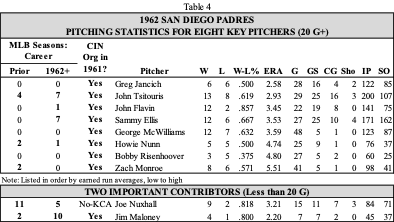The 1962 San Diego Padres: A PCL Pennant … With an Eye on the Major Leagues
This article was written by Tom Larwin
This article was published in When Minor League Baseball Almost Went Bust: 1946-1963
1962 San Diego Padres. (Courtesy of Tom Larwin.)
The San Diego Padres’ first season in the Pacific Coast League was 1936. The team’s last season in the PCL was 1968. In only four of those 33 years did the Padres finish in first place.
This story is about one of those four teams, 1962, when they ran away with the pennant and had wrapped up first place by the end of August.
The 1962 PCL season was the fifth year that followed the end of the league’s “Golden Age,” the period from 1903 to 1957, before the National League’s Giants and Dodgers franchises took up residency in San Francisco and Los Angeles respectively.1
The move of two teams to the West Coast in 1958 was followed by the major-league owners’ actions in 1960 to expand each league by two teams, the American League in 1961 and the National League in 1962. More expansion of the two leagues was anticipated in the future and in 1962 it was a hot topic, particularly in cities in the South and West, like San Diego, that were experiencing high population growth.
With the above as background, here is the story of the 1962 San Diego Padres.
October 1961-March 1962: An Active Offseason
The 1961 baseball season in San Diego was a “downer.” The Padres finished in fourth place, 25 games off the lead, with a record of 72-82 (.468). They were out of contention early in the season.
After the 1961 season, there was disappointment and there was disenchantment—within the Padres organization as well as with the fans and with the San Diego business community. The collective frustration was summarized by San Diego Union beat writer Johnny McDonald in his October 25, 1961, column: “Pained by last year’s experience when veteran ball players failed to live up to past season credentials, the San Diego Padres management will experiment with a younger crop next season.”2
Padres Seek Affiliation with New Club. Within a few weeks of the end of the season, the Padres’ general manager, Eddie Leishman, was pursuing change. Leishman, a career minor leaguer as player and manager, managed teams to pennants in the Pioneer and International Leagues, and then one as general manager of the PCL’s Salt Lake City team in 1959. For the 1960 and 1961 seasons, San Diego’s affiliation was with the Chicago White Sox, and both years the Padres finished in the middle of the eight-team league. Leishman had made it known that he was not pleased with the quality of players being assigned to San Diego by the White Sox.
Barely a month after the end of the 1961 season Leishman made his first significant move, entering into a full working agreement with the Cincinnati Reds, the National League’s 1961 pennant-winner. Padres’ management had strongly bought into the notion that “a tie up with Cincinnati would be a big boost for the Padres and afford them a better chance in obtaining a title contender.”3
Leishman’s belief was that the Chicago farm system had “been going to pieces in recent years,” while Cincinnati’s talent was believed to be so bountiful that the Padres “will have to choose among eight second base candidates when the Padres open camp.”4
New Manager Hired. The next big move came in November 1961with the hiring of Don Heffner as the 1962 team’s manager. Heffner had three decades of professional baseball experience, having played 11 seasons in the major leagues, and managed for nine years in various minor-league levels. Leading up to 1962 he had spent the prior four seasons as a major-league coach with the Kansas City Athletics (1958-60) and Detroit Tigers (1961). Reports were that he was a “good teaching coach” and had the “respect and affection of just about everybody in baseball.”5
San Diego Business Leaders Push for a Major-League Team. For the business community the interest in the 1962 Padres seemingly had three objectives:
- To have a winning team.
- To draw bigger crowds.
- To provide the foundation for a future major-league franchise in San Diego.
With major-league baseball coming west in 1958, and the later expansion in 1961, there was a strong belief in the business community that more expansion was likely and that San Diego should be an attractive candidate.
The business community decided to organize around a strong, clear message, one that would leave no doubt that the city was ready. The result was creation of the Greater San Diego Sports Association to officially launch a “Push the Padres” campaign. One of the objectives was to sell 1962 Padres season tickets, but the other was not at all subtle: getting major-league baseball for the city. This objective was reinforced at the Sports Association’s January 31, 1962, banquet when Buzzie Bavasi, the Los Angeles Dodgers’ general manager, told the crowd, “You’ll have major league baseball here. You have the ideal man here to get it for you—Eddie Leishman.”6
The association was aligned with two other business groups. The Chamber of Commerce had a Sports Committee, which was coordinating San Diego’s sports future for major-league baseball, while the San Diego Hot Stove League was “pushing the Padres boosting ALL baseball.”7
At about the same time, Charlie Finley, owner of the Kansas City Athletics, weighed in with his opinion that San Diego was destined to become a major-league city.8
Lobbying efforts for a major-league franchise continued in mid-March as a delegation of 21 members of the Chamber of Commerce traveled to Phoenix to meet with executives from six major-league clubs. The group’s message rallied around four points:
- Financing was at hand for an “adequate ball park as early as 1963.”
- San Diego’s interests are open to the best proposal from either the American or National League.
- Evidence of local support for major league sports has been demonstrated through the first two seasons of the San Diego Chargers professional football team, which began play in 1960.
- There continues to be major growth in the San Diego region, with 4.0 million people living within 90 minutes of San Diego’s current ballpark.9
As the season proceeded, the subject of expansion was placed on the back burner. Later in the year, at the major leagues’ December Winter Meeting, the owners “agreed that no further expansion would occur without ‘full discussions between both leagues in a joint executive session.’”10 It would take another six years for further expansion to become a reality.
January 1962-April 1962: Building a Roster
The move from the White Sox to the Reds meant a complete turnover in player personnel. Coming off a pennant-winning 1961 campaign, the Reds did not have many holes to plug. Plus, their farm system was in good shape:
- Four of their 1961 minor-league teams finished in first place.
- They had two Triple-A clubs in 1961 (Indianapolis and Jersey City) but only one in 1962, the Padres.
This depth would bode well for San Diego’s 1962 roster.
The makeover for 1962 had its kick-start with the signing of new manager Don Heffner in November 1961.
Based on the quality and depth of the Reds’ minor-league system, the Padres’ primary effort to build a 1962 roster was to evaluate the talent existing in the system.
One example of the depth of the talent: Leishman and Heffner had to choose among eight second-base candidates when the Padres opened spring camp at Tampa, Florida, on March 12.11 One of the candidates was Pete Rose, who would turn 21 in 1962. He had already played two seasons at Class D and had demonstrated that he was a potential .300-plus hitter. Rose did not make the Triple-A club even though he played in a Padres uniform for nine spring games between March 26 and April 3. It wasn’t good enough and he ended up being assigned to the Reds’ Class-A team in Macon (South Atlantic League).
The Padres did add four players in the offseason. One was catcher Jesse Gonder, whom the Reds acquired in a trade with the New York Yankees on December 14, 1961.12 Gonder, a former Reds farmhand, was with the big league team most of the spring before being sent to San Diego on April 3. The other three players were outfielders: Dan Dobbek, acquired in a trade for Jerry Zimmerman of the Minnesota Twins (January 30); Ken Walters, purchased from the Philadelphia Phillies (February 9); and former big-leaguer Jim Pisoni, obtained by the Reds from the Yankees on February 15 in a multi-player trade.13
A key late-spring acquisition for the Padres came on April 9, a week before the start of the season, when right-handed pitcher Jim Maloney was sent down to San Diego by the Reds.
April 17-September 9: The 1962 Season— 21 Weeks and 154 Games
The 1962 Pacific Coast League scheduled 154 games to be played between April 17 and September 9. That totals almost 21 weeks of play and an average of 7.33 games per week. A relief of sorts was provided by a league rule that called for one game of doubleheaders to be seven innings rather than nine.
The Padres’ season of 21 weeks resulted in 18 dates without a game—either due to rain or a game not being scheduled. This was an intense schedule especially considering that one team was in Canada, another in Hawaii, and the other six were scattered in four states. San Diego was the only PCL team in California.
1962 Padres Opening Day lineup
- Chico Ruiz, SS
- Teolindo Acosta, CF
- Jim Pisoni, LF
- Rogelio Alvarez, 3B
- Ken Walters, RF
- Hal Bevan, C
- Harry Anderson, 1B
- Bobby Klaus, 2B
- Jim Maloney, SP
April 17: Opening Day in San Diego. Opening Day was Tuesday, April 17, at the Padres’ home field, Westgate Park. The Padres Opening Day lineup is shown to the right. There were a record 7,152 fans in attendance to witness the 2-1 defeat. Jim Maloney took the loss when the Tacoma Giants scored the go-ahead run in the ninth inning.
April 17-July 1: Weeks 1-11, Reaching the Season’s Halfway Mark. The Padres got off to a slow start. On April 26, with a 10-4 loss to Salt Lake, they finished the 10-game opening homestand with a 4-6 record.
Over the next three weeks it was more of the same mediocrity. On May 15 the Padres lost at Salt Lake City to the Bees, 6-5, and their record plunged to a season low of three games under .500, at 12-15. They occupied fifth place and were nine games out of first place.
A positive break occurred on May 10 when Sammy Ellis arrived after the Reds sent him down. Two days later Ellis pitched a shutout in a 3-0 home win over Portland.
After the May 15 loss, the Padres went on a five-game win streak, with four of them coming against Hawaii at Westgate Park. That win streak left the Padres two games over .500, at 17-15, on May 21.
The team followed that short win streak with two losses to the Vancouver Mounties and were 17-17 on May 25. That day the Padres played at Spokane and Maloney won his second game of the season, 41. This began a run during which the Padres won 12 of 14 games in 13 days through June 6. Maloney won three of the games, with Nuxhall and John Tsitouris each winning two. Nuxhall had an impressive start with a 3-0 shutout in his first game, on May 30. Also during this period, Flavin won his first start as a Padre, a 9-2 victory at Hawaii on June 3.
As of June 7, the Padres had turned things around and had a record of 29-18. They had moved into third place and were only two games out of first place. However, spoiling things a bit was news on this day that the Reds had recalled Jim Maloney (who was 4-1 with a 2.16 ERA) and replaced him with Howie Nunn.
The team’s progress then slowed over the next two weeks, June 7-17, during which they went 5-8. The losses were bad enough, but the last one, on June 17, really stung. On the road against first-place Salt Lake City, the Padres were blown away, 21-7, despite having held a 7-0 lead going into the bottom of the sixth inning. Yet, the Padres were still in the race with a 34-27 record on June 18 that left them three games out of first place.
After losing four in a row to the Bees, on Monday, June 18, the Padres had one last game to play in the teams’ five-game series. After the big 14-run loss on Sunday, the Padres needed a confidence-restoring victory. They got it with a 10-inning win, 11-9, behind Joe Nuxhall.
With confidence seemingly restored after their June 18 win, the Padres went on to win six straight before losing the second game of a doubleheader on June 24 against Portland at home. They ended the day in first place, a half-game ahead of Salt Lake City.
The Padres were on a roll and the next week (June 25-July 1) they won six of eight on the road at Vancouver and Tacoma. With their 12-4 win on June 28 against the last-place Mounties, the Padres took sole possession of first place.
Joe Nuxhall kept things going with a one-hitter on June 30 against the Giants. A scratch hit by Tacoma’s Bob Perry in the top of the eighth inning broke up his attempt for a no-hitter in a 3-0 win.
The next day, July 1, Bobby Klaus hit for the cycle with a single, two doubles, a triple, and a home run.
After a successful month of June, during which the Padres won 23 of 35 games, at the season’s halfway mark on July 2 they were in first place—barely.
Don Heffner. (SABR-Rucker-Archive)
July 2-September 9: Weeks 12-21, Can the Padres Hold First Place to the Finish? The Padres began the second half of the season just as they had the first half … with a loss, this time to the Seattle Rainiers, 3-2. But unlike the first half’s slow start, the team won 10 of its next 12 games.
A key player in the Padres’ rise was third baseman Tommy Harper. His play was getting noticed during the first half and it increased in early July when he hit five home runs over a five-game stretch (July 6-10) leading into the July 11 PCL All-Star Game in Portland.
Harper and four other Padres players were selected to the all-star team: Alvarez, Ellis, Gonder, and Walters … plus, Heffner was to be the squad’s manager.
None of these All-Star picks were surprising. However, it was Tommy Harper receiving most of the attention. With a batting average of .343 and 20 home runs, Harper was off to a great start with the Padres and was selected to start at third base. There was some anxious anticipation in the Padres’ front office that Harper could be called up to the Reds at any time, especially with the call-up deadline date of July 31 being just 20 days away. Pete Seghi, the Reds farm director, commented on whether Macon’s Pete Rose would be Harper’s replacement should the big-league club call up Harper. Seghi responded that Rose was doing a fine job there but might be still a year away from Triple-A competition.15 A day earlier, Seghi was quoted as saying that Rose and Tommy Helms should help the Padres in 1963.16
As for the pitching, on July 12 Nuxhall was at it again, but this time it was because of a home run that he hit in the 10th inning to win his own game, 2-1, at Westgate Park. Catcher Jesse Gonder led the offense in mid-July with six home runs in 13 games, 10 of which were won by San Diego (July 17-28).
Parent Cincinnati was paying attention to the Padres, too, and on July 18 the Reds recalled Nuxhall, who departed with a 9-2 record. The Reds replaced him with Ray Rippelmeyer, who was purchased from the Washington Senators for $12,500.17
In the meantime, two other Padres pitchers were getting hot, Ellis and Tsitouris. On July 27 Ellis won his eighth game against three losses when he struck out 13 as the Padres blanked Vancouver, 2-0, at Westgate Park. That win was followed the next day by another whitewashing as Tsitouris won 6-0, upping his record to 8-6.
With a record of 23-11 in July the wins were not only piling up but so was the team’s first-place lead, which had widened to 7 1/2 games going into August.
On the last day of July, the Padres lost a doubleheader to the Seattle Rainiers. The July wins were in the rear-view mirror as the Padres lost six of their next nine games through August 9. Their first-place lead had been reduced to six games, with the Padres set to face off against their second-place challenger, the Bees, in a five-game home series. It was billed as a “crucial” series: “This home stand could determine whether San Diego will have to struggle the rest of the way in the pennant chase or have enough cushion to claim its first title since 1954. The defending champion Tacoma Giants, currently in third spot, will follow the Bees into town.”18
Behind the pitching of Ellis, the Padres took the first game on August 10, 2-1. Then, leaving little doubt as to the pennant chase, the Padres won the next four games. The Padres’ first-place lead had increased to 11 games on August 14 as the Tacoma Giants arrived in town for a three-game series.
Ellis was the Padres’ starting pitcher in game one of the series. He came into the game with a 9-5 record and came through with a dramatic 4-0 victory. Ellis’s performance was described this way in the next day’s newspaper:
“Wow! The flame-thrower was hot last night.
“Blazing-fast Sammy Ellis, a 21-year-old Birmingham, Ala., righthander, thrilled a huge,overflow crowd of 9,124 at Westgate Park by throwing a no-hit, no-run game to give the San Diego Padres a 4-0 victory over third-place Tacoma.”19
The team won seven of its next nine (August 15-22), but then slumped a bit, winning only two of seven games on the road (August 23-29).
However, as they started play on August 30 in Vancouver, and with 14 games left in the season, the Padres needed only one win or one Salt Lake loss to clinch the PCL pennant.
Next up was a doubleheader on August 31 vs. the Mounties.
Padres’ August 31 lineup (Game 1)
- Chico Ruiz, SS
- Rogelio Alvarez, 1B
- Tommy Harper, 3B
- Jesse Gonder, C
- Ken Walters, RF
- Harry Anderson, LF
- Bobby Klaus, 2B
- Jim Pisoni, LF
- Jon Tsitouris, SP
The Padres game-one lineup is shown above. John Tsitouris started and bagged the win, 3-2. He was backed by a two-run home run by Alvarez and a run-scoring double by Gonder in the second inning. Tsitouris had been a dependable pitcher for the Padres all season and was lauded in the next day’s news:
“The crafty, 26-year-old righthander, who has been the most consistent pitcher on the squad, hurled the Padres into the league lead at this same stadium on June 28 with a 12-4 victory.
“Last night, the Monroe, N.C., athlete fanned six hitters and bore down in the trouble spots to check the dangerous Mounties. This was his 14th complete game in 22 starts and gave him a 13-7 record.”20
The Padres finished their season with a lackluster final two weeks but won the pennant with a 12-game cushion over the two second-place teams. (The Pacific Coast League did not have postseason playoffs.)
The 1962 Pacific Coast League’s final standings are shown in Table 1.
The 1962 Padres’ Core Players
During the season, the Padres used 30 players. Sixteen were pitchers and the other 14 were position players. A team photo of the 1962 Padres is shown in Figure 1.
Over the course of the 154-game season there were nine core position players who each played in 100 or more games for the team. The nine players are listed in Table 2 with the number of games they played shown, both by their total, and by games played at their primary position.
Table 3 provides the season’s batting statistics for the core nine. Also shown on the table for each player are the number of major-league seasons played, prior to 1962, and for 1962 and after. Finally, Cincinnati’s influence on building the roster is exemplified by noting whether the player was in the organization in 1961.
The key offensive leaders on the team were:
- Jesse Gonder, .342 average, 116 RBIs
- Tommy Harper, 1.020 OPS, 120 runs, 26 home runs
Table 4 shows the pitching statistics for eight core pitchers, defined to be those who pitched at least 20 games for the Padres. However, two pitchers with fewer than 20 games—Joe Nuxhall and Jim Maloney— were added to the core group due to their immense contributions during their relatively short stays with the team.
The team’s pitching leaders were:
- John Tsitouris, 13 wins, 16 complete games, 200 innings pitched
- Greg Jancich, 2.58 ERA
- John Flavin, .857 W-L percentage
At a ceremony held before the last game of the season, on September 9, Jesse Gonder received the team’s Most Valuable Player trophy, and John Tsitouris was named the most valuable pitcher.21
Retrospective
The Team’s Position Players Were a Talented Core Group Who Played the Entire Season. The article’s headlines in The Sporting News said it well:
“Champion Padres Toss Posies to Reds for No-Shuffling Tieup
“Cincy Called Up Only Single Key Player, Nuxhall, and Sent Quick Replacement”22
From the opening game to game number 154, manager Heffner was able to count on nine position players to play in a majority of the games. Offensively, they offered a balanced attack game after game with the same core players being in the lineup. There were no major disruptions due to injuries or to shuffling back and forth with the parent Reds.
As a testament to the team’s talent, at the end of the season six Padres were selected to the PCL All-Star team as the best at their position:
- Rogelio Alvarez, 1B
- Tommy Harper, 3B
- Chico Ruiz, SS
- Ken Walters, OF
- Jesse Gonder, C
- John Tsitouris, RHP
Padres’ management also was recognized, with Eddie Leishman being voted as the PCL’s General Manager of the Year.
Gonder received more, and bigger, laurels when he was named the PCL’s 1962 MVP and won the Topps-J.G. Taylor Spink Minor League Player of the Year Award.23
Padres’ Offensive Leaders Were League Leaders. The 1962 Padres had four players who led the Pacific Coast League in these key offensive categories:
- BA: Jesse Gonder, .342 (second was Tommy Harper, .333)
- RBIs: Gonder, 116
- OPS: Harper, 1.020
- Runs: Harper, 120
- SB: Chico Ruiz, 40
- 2B: Ken Walters, 43
- BB: Harper, 105
Cincinnati’s Talented Farm System Provided the Foundation for a Winning Team. Of the 1962 Padres’ 19 core players, 15 were with the Cincinnati organization, at one level or another, in 1961.
The Majority of the Core Players were, or Would Be, Major-League Players. Further underscoring the excellent talent on the 1962 Padres was the high number of players who would play in the major leagues. All nine of the core field position players played two or more years at that highest level. Of the 10 core pitchers, seven played in the major leagues. After the 1962 season, five of the core 19 would go on to play five or more seasons in the major leagues. Tommy Harper led the way with 15 seasons, followed by Jim Maloney with 10 and Chico Ruiz with 8.
Guarded Optimism Regarding Having a Major-League Team. Early in 1962 the business community was convinced that San Diego was ready for a major-league team. The emotion died down a bit during the season. However, in September team President Jim Mulvaney said, “I think we must hold on until the major leagues expand to 12 teams. I would think this will be in about two to three years.”25 That hope was optimistic as it took seven more years before the National League Padres took the field.
TOM LARWIN, a retired transportation engineer, grew up in Chicago as a Cubs fan. After a move to San Diego in 1976, he gradually shifted allegiance to the hometown Padres. His first SABR essay was about Walter Johnson and the 1907 San Diego Pickwicks, published in The National Pastime (1999). His baseball research passion is pursuing the history of baseball in San Diego from 1870 to 1936.
NOTES
1. The Pacific Coast League’s history has been characterized as having four eras: The “Golden Age” from 1903-1957, the “Silver Age” from 1958-1968, the “Modern Age” from 1969-1997, and the “Platinum Age” from 1998 on. (Source: Mark Macrae, “Welcome to the ‘New’ Potpourri!,” Pacific Coast League Potpourri, April 2017 (Pacific Coast League Historical Society): 1.
2. Johnny McDonald, “Padres Sign With Cincinnati,” San Diego Union, October 25, 1961: 29.
3. McDonald, “Padres Sign With Cincinnati.”
4. Jack Murphy, “Only One Restriction on Padre Boss: Stay Away from the Ducks,” San Diego Union, February 18, 1962: 105.
5. Jack Murphy, “Heffner Appears Likely Choice to Pilot Padres Next Season,” San Diego Union, November 29, 1961: 31.
6. Gene Gregston, “Padres’ Ticket Drive Aimed at Future Big-Time Ranking,” The Sporting News, February 14, 1962: 25.
7. Advertisement, 1962 San Diego Padres Official Program and Scorecard: 20.
8. Phil Collier, “Finley OKs San Diego,” San Diego Union, March 11, 1962: 109.
9. Bob Williams, “Baseball Boosters to Woo Majors,” San Diego Union, March 17, 1962: 19.
10. Chris Jones, “1962, Addition by Subtraction” in Steve Weingarten and Bill Nowlin, eds., Baseball’s Business: The Winter Meetings, Vol. 2,1958-2016 (Phoenix: SABR, 2017), 31-35.
11. Jack Murphy, “Only One Restriction on Padre Boss: Stay Away from the Ducks,” San Diego Union, February 18, 1962: 108.
12. The trade involved pitcher Marshall Bridges being sent to the Yankees.
13. “Asaro Glad to Be Here,” San Diego Union, February 15, 1962: 11, 13; Laurence Leonard, “Sports,” Richmond (Virginia) News Leader, February 15, 1962: 47.
14. Nuxhall was purchased from the Orioles before the start of the season and then released by the Angels. The San Diego signing gave him a new lease toward a successful major-league career.
15. Johnny McDonald, “Countdown for Harper in Padres’ Camp,” San Diego Union, July 12, 1962: 11.
16. Seghi was correct about Helms, who played three years with the Padres (1963-65) before having an excellent major-league career. He was wrong with regard to Rose, who was good enough to play for the Reds in 1963 and be voted National League Rookie of the Year, beginning a career in which he set the major-league record for total hits with 4,256.
17. Rippelmeyer was drafted by the Senators from the Reds in a Rule 5 draft, then returned to Cincinnati.
18. “Pads Host Bees Tonight,” San Diego Union, August 10, 1962: 11.
19. Johnny McDonald, “9,124 See Padres’ Ellis Hurl No-Hit 4-0 Victory,” San Diego Union, August 15, 1962: 27.
20. Johnny McDonald, “San Diego Wins 3-2, 6-3: First Title in 8 Years,” San Diego Union, August 31, 1962: 32.
21. Johnny McDonald, “Padres Split With Seattle to Close ‘62 PCL Campaign,” San Diego Union, September 10, 1962: 25.
22. Earl Keller, “Champion Padres Toss Posies to Reds for No-Shuffling Tieup,” The Sporting News, September 15, 1962: 39.
23. Advertisement, Topps Chewing Gum Co., “Meet the Winner of the Topps-J.G. Taylor Spink Minor League Player-of-the-Year Award,” The Sporting News, October 20, 1962: 39.
24. Harper had 22 stolen bases for the season and the Padres as a team had 78. Together, Ruiz and Harper accounted for almost 80 percent of the team’s stolen bases.
25. Johnny McDonald, “Padre-Red Pact Renewal Due,” San Diego Union, September 11, 1962: 22.
